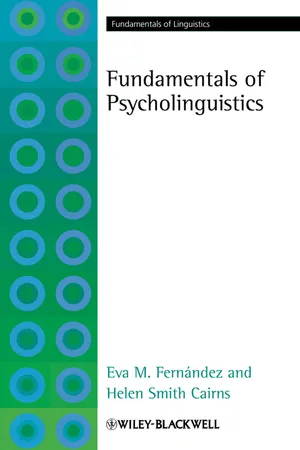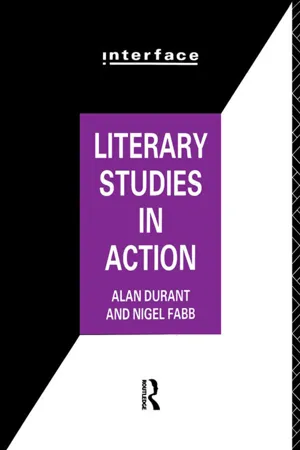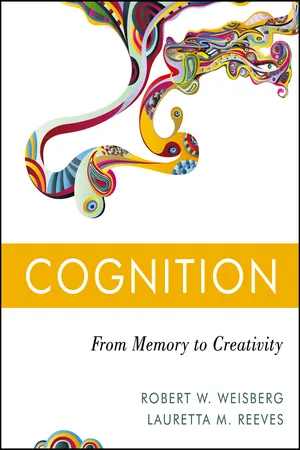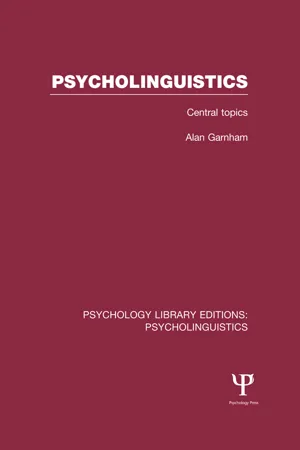Languages & Linguistics
Language Structure
Language structure refers to the systematic organization of elements within a language, including its phonology, morphology, syntax, and semantics. Phonology deals with the sound system, morphology with word formation, syntax with sentence structure, and semantics with meaning. Understanding language structure is crucial for analyzing and comprehending the complexities of different languages.
Written by Perlego with AI-assistance
Related key terms
Related key terms
1 of 4
Related key terms
1 of 3
7 Key excerpts on "Language Structure"
- eBook - ePub
- Jean Piaget(Author)
- 2015(Publication Date)
- Psychology Press(Publisher)
Language, in short, is independent of the decisions of individuals; it is the bearer of multi-millennial traditions; and it is every man's indispensable instrument of thought. As such, it appears to be a privileged domain of human reality, so it is only natural that it should sometimes be regarded as the source of structures which, on account of their age, generality, and power, are of special significance (that language and its structures far antedate science goes without saying).Before taking up linguistic structures as the linguists understand them, we should note that there is an entire school of epistemology—logical positivism—according to which logic and mathematics furnish a "general syntax" and "general semantics"; seen from this perspective, the formal structures described in Chapter II are already "linguistic." This is not how we viewed them. We dealt with logical and mathematical structures as the products of "construction" and what we called "reflective abstraction," intellectual activities which ultimately derive, we said, from the processes of assimilation and accommodation whereby sensori-motor acts become coordinated with one another, and it is this activity of coordinating our own acts which we regarded as primary: applying to everything, it applies to acts of communication and exchange as well, consequently, to language. Linguistic structures lose none of their interest by being looked at in this way, but their relations to the structures of the signified become different. In whatever way the problem as to the relation between linguistic and logical structure be solved eventually, it is a fundamental problem for any general theory of structure.Linguistic structuralism in the narrower sense goes back to Saussure, who showed that diachronic development is not the only process to be taken notice of in the study of a language, and that in fact the history of a word may give a seriously inadequate account of its meaning. In addition to its historical aspect language has a "systematic" aspect (Saussure did not use the term "structure"); it embodies laws of equilibrium which operate on its elements and which, at any given point in its history, yield a synchronic system. Since the basic relation in language is that between the sign and its meaning, and since meanings are relative to one another, the system is one of oppositions and differences; while it is synchronic because the meaning-relations are interdependent.1 - eBook - ePub
Powerful Book Introductions
Leading with Meaning for Deeper Thinking
- Kathleen Fay, Chrisie Moritz, Suzanne Whaley(Authors)
- 2023(Publication Date)
- Routledge(Publisher)
Readers use knowledge of how English works and what they’ve heard spoken and read to search for information in their reading and monitor whether their reading sounds right. All readers are language learners to some degree. Even adults stumble when they encounter something their ear hasn’t been attuned to yet. To empower readers to access the meaning of unfamiliar Language Structures and complex sentences, we analyze texts with the students’ oral language abilities in mind so that we may anticipate what might be new or unusual for them. Then, we can consider how to support readers with those Language Structures that fall outside of their oral language use. This chapter will help you do just that as we explore- what syntax is and how readers use it,
- a process for analyzing Language Structure complexity when planning a book introduction, and
- suggestions for supporting readers in noticing and using Language Structure.
SYNTAX: HOW LANGUAGE WORKS AND SOUNDS
We use the term Language Structure to refer to grammar, sentence structure, or syntax: the way words are put together in rule-governed ways. The concept of syntax, or Language Structure, connects directly to the work many of us do when analyzing running records. To make sense of texts, readers use any combination of three main sources of information while reading: meaning, structure, and visual. Errors and self-corrections during a running record are coded M, S, or V to give us a clear view of the sources of information used or neglected to make attempts and problem-solve while reading:- M—meaning or semantics. The reader uses pictures, context, and background knowledge to consider a sensible possibility.
- S—structure. The reader uses syntax or what sounds grammatically correct in the English language.
- V—visual or graphophonemic information. The reader uses the print on the page: the letters and the sounds they make, parts of words, and whole-word units.
- eBook - ePub
- Eva M. Fernández, Helen Smith Cairns(Authors)
- 2010(Publication Date)
- Wiley-Blackwell(Publisher)
Peggy or to somebody else altogether (say, some female mentioned earlier). The grammar restricts the reference of pronouns by specifying what a pronoun cannot refer to. But the grammar never requires a pronoun to have a particular referent (except in the case of reflexives). How is the referent of a pronoun selected, then? Considerations beyond the sentence come into play, including the context in which the sentence was used, the plausibility of a given interpretation vis-à-vis another interpretation, and so on. Weighing these considerations to come up with an optimal interpretation of the sentence is a function of linguistic performance (psycholinguistic processing), not linguistic competence (grammar). We will return to this in Chapters 7 and 8.Summary: SyntaxThe syntactic component of the grammar contains principles which govern the creation of simple and complex structures of hierarchically related constituents, and which move such constituents around. Syntactic principles are structure dependent and are restricted by structural factors, but not by non-structural considerations such as the number of embedded clauses in a sentence or the linear order of the words.Metalinguistic Awareness and the Psychological Reality of Linguistic StructureThroughout the preceding sketch of the operation of the syntactic component of the grammar, the examples (in the languages you know) have appealed to your metalinguistic awareness, the ability you have to think consciously about language and linguistic objects (sounds, words, sentences) apart from their use in ordinary communication. When people use language to communicate and interact with others, they are completely unaware of the linguistic system they are summoning to do that. But if asked to contemplate that system, they are able to do so – to a certain extent. Linguistic competence constitutes knowledge of language, but that knowledge is tacit, implicit. This means that people do not have conscious access to the principles and rules that govern the combination of sounds, words, and sentences; however, they do recognize when those rules and principles have been violated. The ability to judge such violations constitutes an important aspect of metalinguistic skill. It is also a powerful demonstration of the psychological reality of grammar. If you can judge when a principle or rule has been violated, you can be sure that it is mentally represented somehow. For example, when a person judges that the sentence John said that Jane helped himself is ungrammatical, it is because the person has tacit knowledge of the grammatical principle that reflexive pronouns must refer to an NP in the same clause. Another kind of metalinguistic skill is involved in perceiving the ambiguity of sentences. The perception of global structural ambiguity – that is, that a sentence can have two different meanings based on two alternative structures – illustrates the psycholinguistic information that can be obtained from metalinguistic judgments. Recall once again the ambiguous sentence from example (6 - eBook - ePub
- Rebecca Bunting(Author)
- 2013(Publication Date)
- David Fulton Publishers(Publisher)
Most speakers and writers take for granted that the context determines the language used. Imagine two people who have never met before sitting next to each other on a plane. How do they know what to say to each other? What is the context here? It is certainly not just a pressurised cabin. The context changes and shifts during the flight, as experiences and knowledge are shared. Sapir (1921), an American linguist and anthropologist working in the late nineteenth and early twentieth centuries, argued that language cannot exist apart from culture. By culture he meant the sets of practices, beliefs and systems which are the fabric of daily life.Consciously and unconsciously we make choices from our available linguistic repertoires to create spoken and written texts, operating within conventions, and sometimes outside conventions so that new uses of language emerge. We take into account a whole range of features which comprise the context and we construct our written or spoken discourses accordingly.A STRUCTURALIST MODEL OF LANGUAGEThe way I was teaching language in my early teaching days might be described as conforming to a structuralist model: it treated language as an autonomous mechanism with cogs and pulleys called sentences, phonemes and morphemes. It had its origins in the post-Renaissance period, when, perhaps surprisingly, the main players in the study of language were scientists, trying to render language amenable to rational analysis in the way that the study of the natural world was also being treated. One highly influential book, The Rudiments of English Grammar (1761) was written by Joseph Priestley, the chemist who discovered oxygen. This may not be as strange as it seems. It is not too difficult to see a similarity between grammar and chemistry: both are transformational, combining units to make new units, with words and their parts, and molecules and their parts, the building bricks in each discipline. Just as molecules combine to form compounds, so morphemes (the parts that words are made from) combine to form words.The purpose of such early grammar books was to standardise, to identify and to describe the English language so as to set the standard for future generations and across the world. Samuel Johnson’s dictionary, begun in 1747 and published in 1755, was intended to contribute to this process of standardisation, to fix meaning and spelling and to preserve the ‘purity’ of the language. This Johnson expounded in his Plan of a Dictionary of the English Language - eBook - ePub
- Alan Durant, Nigel Fabb(Authors)
- 2006(Publication Date)
- Routledge(Publisher)
6 Language in textsIn this chapter we concentrate on close analysis of the language of texts written in English. In particular we look at ways in which the English language enables texts to have structure and meaning. We might usefully distinguish two roles which the English language plays in a text.(a) It is one of the materials from which the text is made.(b) It provides part of the knowledge and abilities we bring to a text when we read it; it is these abilities which enable us to make sense of the text.The fact that language plays these two different roles raises a general problem, which we will need to consider. Are the patterns in language which we identify (such as alliteration, repetition of words and phrases, rhyme, cohesion, etc.) in the text, independent of us as readers, or are they something we create in the text as we read. We will tackle this problem in Chapter 7 . In the present chapter we will consider some of the many different kinds of structure in language which organise texts.6.1 The sound structure of spoken English
English is an example of a language which can be expressed in both mediums of sound and writing (some languages, such as British Sign Language, do not use sound, while others have never been written down). If we analyse a piece of spoken English, we can identify three distinct layers' in the flow of sound. The first layer is the sequence of sound segments, or phones. A word is made of a sequence of phones, one after another, in much the same way that a written word is made of a sequence of letters. In English, the phones in a word form clusters called syllables. A syllable normally consists of one vowel, with one or more consonants before it and one or more consonants after it. Below is a transcription of the English word ‘alphabetic’, represented as a sequence of letters, phones, and syllables (the Greek letter s here stands for ‘syllable’).Note that though sometimes a single letter stands for a single phone (e.g. here the letter ‘a’ stands for a single sound which we write ‘æ’, and the letter ‘b’ for the sound ‘b’), at other times, two letters stand for a single sound (e.g. ‘p’ and ‘h’ together stand for one sound, written ‘f’). The letters of English do not stand very accurately or consistently for the sounds of English; for example the letter ‘a’ can stand for different sounds (compare the ‘a’ in ‘father’ with the ‘a’ in ‘at’) and so can the letter ‘c’ (in ‘ceiling’ and in ‘alphabetic’). For this reason a slightly different ‘alphabet’ is used for sounds than for written letters, particularly for vowels. - eBook - ePub
Cognition
From Memory to Creativity
- Robert W. Weisberg, Lauretta M. Reeves(Authors)
- 2013(Publication Date)
- Wiley(Publisher)
We all suffer from tip-of-the-tongue states occasionally, especially for low frequency words. However, even in TOT states, people often have partial information about a target word available, such as the first or last phoneme or syllable (Brown & McNeill, 1966). With both normal people and pure anomics, the block seems to be at retrieving the phonological representation of the word, which is why phonologically related hints often facilitate retrieval. Research on processing lexical ambiguity indicates that multiple meanings of words are often activated, and then the system utilizes the interpretation that best fits the sentence context. When a context is provided by a sentence or other constraining factor, the irrelevant meaning may be suppressed in favor of the context-relevant interpretation. In this way, a person's mental lexicon can accommodate the multiple meanings of many words, without the meanings of words being in competition with each other indefinitely. In addition, studies of brain functioning in lexical access indicate that there may be lateralization of meanings of ambiguous words. Such studies shed light on lexical storage of words, and psychological processes such as word retrieval.The Meaning Structure of Words: Morphological Analysis
Many words have a complex internal structure that allows people to use language creatively and to convey subtleties about words and meanings. Consider, for example, the word untied, as in I untied my shoes. Untied has three parts: tie, which is a word that has meaning and can stand on its own; and un- and -ed, both of which are not separate words, but which convey meaning nonetheless. Un- tells you that the action being carried out is the opposite of tie, and -ed tells you the action took place in the past. These small particles of meaning, the smallest units of meaning in a language, are called morphemes. Books is constructed out of two morphemes—book plus the plural morpheme -s, which signals that more than one book is being discussed. Morphemes, such as tie and book—single words that can stand alone—are called free morphemes. Morphemes that cannot stand alone, like un-, -s, and -ed, are called bound morphemes. The study of the morphemic structure of words is called morphology. Specifying the mechanisms through which we combine morphemes into words will help us understand important aspects of language functioning and language development.Morphological Rules
There is a high degree of regularity in how bound morphemes are combined with free morphemes to create new words. As one example, verbs are made into adjectives in English by adding suffixes, or endings, such as -able, as in imaginable. The suffix -ism (as in Darwinism, or Marxism) makes one kind of noun out of another (“I am not a believer in Marxism”). The suffix -ian, as in Marxian or Mozartian, makes an adjective out of a noun (“That philosophy sounds Marxian”). Similarly, the suffix -er makes any verb a noun, as in writer and reader. There is ample evidence from adult, child, and aphasic data that we access morphemes separately when we speak (e.g., read + er - eBook - ePub
Psycholinguistics (PLE: Psycholinguistics)
Central Topics
- Alan Garnham(Author)
- 2013(Publication Date)
- Psychology Press(Publisher)
8 The structure of the language processorIn the preceding chapters the major component processes of language understanding have been described. These processes can be divided into three groups: word-level processes, syntactic processes, and what Forster (1979) has called message-level processes – that is to say, those processes that compute the various aspects of the meaning of a discourse or text. The first set of processes determines, on the basis of perceptual and contextual inputs, what words have been presented to the understanding system; the second set computes the structural relations between the words; the last set uses these structural relations, together with context, to ascertain the import or significance (Johnson-Laird, 1977b) of what has been said. These three sets of processes can be ordered with respect to one another in the following sense. All the words in a sentence could, in principle, be recognized before any syntactic structure has been assigned, but a complete syntactic analysis cannot be generated before any words have been recognized. Similarly, parsing could precede the interpretation of a sentence or text, but interpretation cannot proceed in the absence of any syntactic information. However, these logical considerations place only weak constraints on how the three sets of processes work together. Once the lower-level processes have produced partial analyses, those at a higher level can begin their computations, and their outputs may be fed back to lower levels.Psycholinguists have asked two main questions about how the three processors operate. First, at what point in a sentence do the syntactic and message-level processors begin their computations? Although there is strong introspective evidence that words are recognized almost as soon as they are read, this evidence does not show when a more detailed understanding is achieved. Further analysis could be delayed, for example, until a sentence or clause boundary is reached. Second, do the lower-level subprocessors act independently of the higher-level ones, or can information flow back through system? Two subsidiary questions are: if information is passed back, what information and when?
Index pages curate the most relevant extracts from our library of academic textbooks. They’ve been created using an in-house natural language model (NLM), each adding context and meaning to key research topics.
Explore more topic indexes
Explore more topic indexes
1 of 6
Explore more topic indexes
1 of 4






